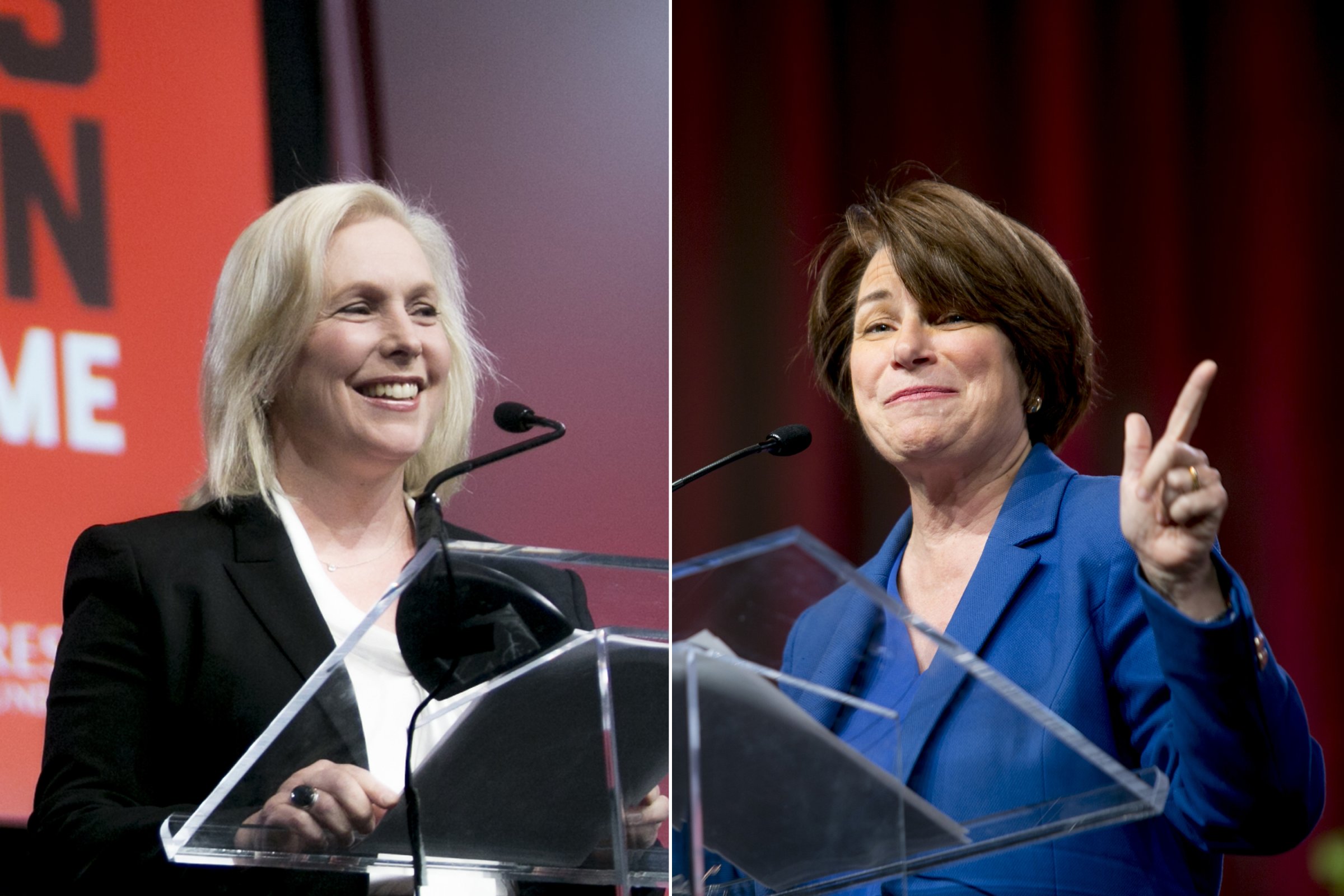
How do you run as a woman during a feminist revolution?
Speaking to the Women’s Convention in Detroit on Friday, Sen. Kirsten Gillibrand of New York and Sen. Amy Klobuchar of Minnesota, two popular Democrats and potential 2020 presidential contenders, offered a glimpse of two different strategies.
Gillibrand’s speech hit all the obvious feminist notes. She lingered on women’s history, placing the current Women’s March movement in the same lineage as Susan B. Anthony and the Suffragettes. She emphasized the importance of paid family leave and sexual assault policies, both causes she has championed in the Senate. And she stressed that more women in government would mean inevitable progress on issues like birth control, sexual harassment and family leave.
“Just imagine if Congress was 51% women,” Gillibrand said to a standing ovation. “Do you think we’d be fighting for access to birth control now? Do you think we’d still be fighting to end sexual assault in college campuses and in the military? Do you think our Dreamers would be political pawns? Do you think it would be so hard to change workplace rules that are stuck in the Mad Men era?”
The speech contained echoes of Gillibrand’s fellow New Yorker and former colleague Hillary Clinton, who ran a more explicitly female-focused campaign than any other woman presidential candidate. (Few women have ever run for President, and Clinton is still the only female candidate to win a nomination of a major party, or the popular vote.) Gillibrand ended her speech with a call to action for women and girls that mirrored Clinton’s concession speech shout-out “to all of the little girls who are watching this, never doubt that you are valuable and powerful and deserving of every chance and opportunity.”
Gillibrand spun it forward: “Not until every American woman and girl can reach their potential will America reach hers.”
If Gillibrand’s speech was one preview of how a female presidential campaign might campaign in 2020, Klobuchar presented herself as an capable contender who just happened to be a woman.
Klobuchar referenced the recent spate of harassment allegations, but used the issue to discuss class distinctions. “We make sure it isn’t just famous people who are heard,” she said. “We protect the shift worker at the factory, the teacher at the school, the nurse at the hospital, all women deserve to be safe wherever they work and wherever they are.”
Klobuchar outlined a four-point agenda that focused more on broader economic prosperity than female representation. Speaking to an audience in Michigan, the Minnesotan anchored her pitch in the Midwest, where Clinton had trouble in 2016. “The Midwest matters,” she said, “and next time we cannot leave the middle of the country behind.” She then outlined an economic to-do list that involved lowering costs for prescription drugs, air travel and student debt. She urged government to take on the pharmaceutical lobby and endorsed Sen. Elizabeth Warren’s plan to refinance student loans.
Both speeches embraced the economic spirit of Sen. Bernie Sanders’ 2016 campaign. Gillibrand condemned the “soft corruption of money in politics” and described health care as a “right, not a privilege.” Klobuchar called for an “economic agenda for America” and a manufacturing economy that “leaves no people behind.” They both called for tougher regulations on big corporations and more transparency about money in politics.
How to approach the role of gender in politics is a critical choice facing many female politicians at a moment when women have emerged as the engine of the new left. The day after Trump’s inauguration, nearly 5 million women flooded the streets for the Women’s March, which became the largest demonstration in U.S. history. Stalwart progressive organizations like Planned Parenthood, upstart groups like Indivisible (whose base is 74% female) and self-organizing groups of concerned mothers helped stymie the Trump Administration’s efforts to repeal and replace the Affordable Care Act. A record 51 women ran in Virginia’s Democratic primaries for the House of Delegates, nearly double the number in 2015. And the Women’s Convention in Detroit is hosting workshops and panels to coach even more women to run for office.
This momentum, coupled with the raw anguish felt by many women after Clinton’s loss, suggests Democrats may decide to nominate another female presidential candidate in 2020. One likely contender is Warren, who has long captivated the left wing of the party. Gillibrand and Klobuchar are two other potential candidates. Both mentioned Warren in their speeches, endorsing both her legislation (to refinance student loans) and her rhetoric (the “rigged system”).
No matter how you do it, playing the “woman card” is risky. It can mobilize some women but alienate others, and it’s not clear whether women’s empowerment is a winning issue with anybody who doesn’t already call themselves a feminist. According to an October Pew survey, 44% of American men and 33% of women say gender equality has been “about right,” while 13% of men and 8% of women say it’s gone “too far.” A feminist campaign is also unlikely to win over many Trump voters: 22% of Republican men say they think gender equality has “gone too far.”
With more than three years to go and countless twists ahead, both Gillibrand and Klobuchar have plenty of time to perfect their messaging should they choose to run in 2020. But if they do make a bid, they’ll have to figure out that impossible puzzle: how to make progress for women while transcending gender, how to be both female and human at the same time.
More Must-Reads from TIME
- Your Vote Is Safe
- The Best Inventions of 2024
- How the Electoral College Actually Works
- Robert Zemeckis Just Wants to Move You
- Column: Fear and Hoping in Ohio
- How to Break 8 Toxic Communication Habits
- Why Vinegar Is So Good for You
- Meet TIME's Newest Class of Next Generation Leaders
Write to Charlotte Alter/Detroit at charlotte.alter@time.com